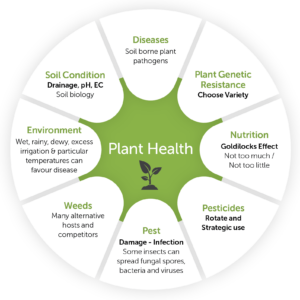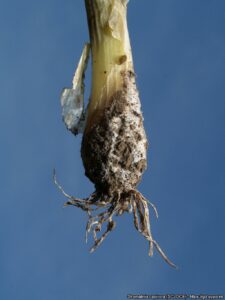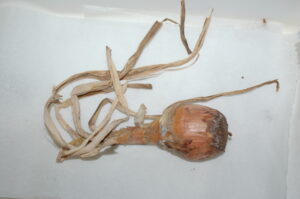Onion consumer usage and attitudinal study
Onion-specific Phenomenom resource creation
Vegalogue #3 – European certification schemes, capsicum internal rot, Pirrone Brothers
Managing soil borne diseases in onion crops
ATMAC European Study Tour: Wholesale & retail, Fruitnet, Red Tractor
The main soil borne diseases in onions include damping off, white rot, basal rot and pink root. Prevention and management can often be improved via managing soil health to increase plant resilience.
The soil environment includes good and bad fungi, nematodes and microbes. Soil borne diseases are plant pathogenic soil microorganisms that attack the plant roots; they are part of the overall soil environment. In most cases, soil borne plant diseases can survive in the soil for a long time without a host plant present.
The zone in the soil where most of the disease activity occurs, surrounds the roots, where the biology and chemistry are affected by plant secretions, and in onions it is the rhizosphere surrounding the roots up to 5mm distant.
According to Dr Len Tesoriero, understanding the soil environment and the factors that can affect its health are an integral part of managing diseases to control their spread in the soil.
Pests such as insects, can potentially move spores from plant to plant increasing the spread of the disease. However, insects can also cause physical damage to the plant, creating stress and weakening the plant health, or providing a wound for diseases to enter.
“The Goldilocks effect relates to nutrition – you want to have not too much, nor too little,” said Dr Tesoriero. “For some diseases, the form of nitrogen fertiliser can be a factor. We know that ammonium-based fertilisers favour infection and disease severity caused by Fusarium oxysporum. So gradual applications of lower doses or use of nitrate-based fertilisers is less likely to cause severe basal plate disease of onions.”
When plants are stressed such as through too much or too little water, heat or wind, pathogens are more likely to attack, commented Dr Doris Blaesing.
To give the onion plant a better fighting chance, choose varieties that have greater genetic resistance to soil borne diseases. The use of sentinel plants that have lesser resistance, can also be a useful method of determining and monitoring the extent of a soil borne disease. Using soil DNA testing is the best way of finding out whether a soilborne disease risk exist in a paddock.
“Many weeds are in themselves hosts to soil borne pathogens, so care needs to be taken to remove them and allow time for the population to die down before planting again through longer rotations, and fallow beds,” Dr Tesoriero. “Cover crop choice also needs to be carefully considered, as many crops are also hosts for pathogens.”
Soil conditions and environment play their part in soil borne diseases. By understanding the optimum conditions for plant pathogens such as soil and air moisture, temperature and pH, tactics such as delayed planting, knowing when to stop irrigating, and plant spacing can be employed to lower the occurrence and spread of specific pathogens. It is also known that some pathogens form complexes where one will work in tandem with another such as in pink root which is caused by Setophoma terrestris but is also often associated with common soil borne pathogens Pythium and Rhizoctonia..
“An example is a Tasmanian onion farmer who late in the season had no weeds, the soil was still fluffy and achieved consistent yields across the fields because of the soil health management for his site,” said Dr Blaesing.
“Most soil pathogens like moist soil, so minimum tillage, good organic matter and cover crops with long rotations will all help to lower the risk of soil borne diseases.”
Common diseases in onions and their management
White rot
Pathogen: schlerotium cepivorum
Occurs: pre-emergent, early leaf
Symptoms:
Lifespan: long term
Environment: cool, wet soils 14-18oC
More common in spring onions, white rot is caused by Sclerotium cepivorum which forms small black bodies which are the schlerotia of the fungus. It can survive for many years in the soil and prefers cool and wet soils, ideally in a temperature range of 14-18oC.
Management
- Farm hygiene is the priority – it can be transported via infected soil on farm equipment
- Keep the nutrition balance with manganese and copper availability
- Fungicides – Hort Innovation project VN20007 is currently investigating the efficacy of two new fungicides for White Rot
- Cover crops and rotations – will increase soil microbial diversity, but long rotations between onion crops is required as it can survive for more than 25 years
- Increased plant spacing – tightly packed plants allow for easy movement between plants.
Black mould
Pathogen: aspergillus niger
Occurs: post harvest, storage
Symptoms: physical damage or bruising through the stalk
Lifespan: long term
Environment: high humidity >76%RH, high temperatures (>30 oC in field; >24 oC in storage)
Management
- withdraw irrigation 21 days prior to harvest to prevent moisture build-up, which can escalate infection significantly
- avoid bruising or mechanical damage to the bulbs to reduce infection points
- dry or cure the bulbs at 36% RH and at 38oC
- Fungicides can be applied (fludioxonil + cyprodinil)
- Application of copper prior to harvest can be beneficial to reduce storage rot
Pink Root
Pathogen: Setophoma terrestris (previously called Phoma terrestris or Pyrenochaeta terrestris
Occurs: post harvest, storage
Symptoms: wilting, yellowing and brown tip of leaves, soft bulbs
Lifespan: short term – 3 years
Environment: warm temperatures (24-28 oC)
Management
- Long crop rotations in the order of 3-6 years. This pathogen has a range of host plants including pumpkin, bean, carrot and pepper families, as well as many legumes, maize, millet and sorghum. It is also known to form disease complexes with root pathogens such as pythium, rhizoctonia and fusarium.
- Harvest before the soil temperature gets to 30 oC
- Avoid plant moisture stress – regular and less irrigation
- Soil fumigation may be helpful
Basal Rot
Pathogen: Fusarium oxysporum and other Fusarium spp
Occurs: young seedlings
Symptoms: yellow to light brown discolouration around the base of the stem, wilting, death
Lifespan: >10 years
Environment: temperatures (5-15 oC), damp, cool, compacted soils
Management
- Raised beds or well drained soil
- Treat seeds/seedlings with a registered fungicide
- Host plants carrying Fusarium are wide including legumes and most vegetable crops
- Avoid using excessive amounts of ammonium forms of nitrogen, with a balance of Ca and Zn if needed
- Avoid plant damage, including mechanical, insect, nematode and herbicide injury
- Soil fumigation may be helpful
To watch the webinar visit https://www.soilwealth.com.au/resources/webinar-recordings/soilborne-disease-management-in-onions/
This project (VN18003) has been funded by Hort Innovation using the onion research and development levy and funds from the Australian Government. This article published in Australian Grower magazine Spring 2023




